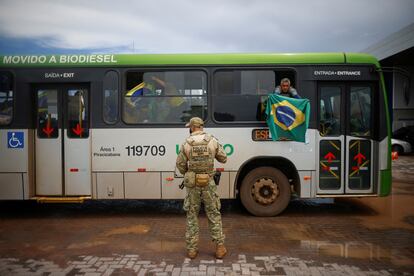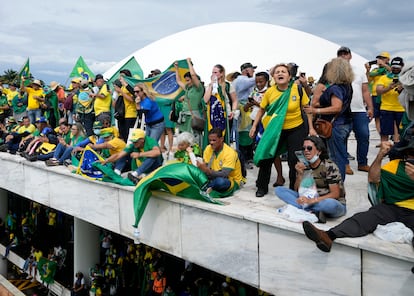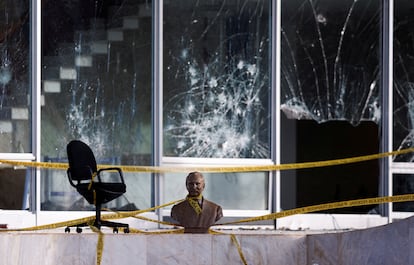Was the Military Police protecting the Brazilian rioters?
Bolsonaro supporters arrived in the capital city on buses escorted by the same security forces responsible for public safety


One of the big differences between the January 6 assault on the US Capitol two years ago and the January 8 attack on Praça dos Três Poderes (Three Powers Plaza) in Brasília this year is that the element of surprise was crucial for the Trumpist insurrection. The police guarding the US Capitol couldn’t believe what was happening, and some lost their lives trying to stop the attack. Millions of stunned people around the world watching it all unfold on television couldn’t believe it either. But in Brazil, the threat had been clear and present for months. The surprise in Brasília was not the riot itself, but that supporters of defeated former president Jair Bolsonaro were escorted to the gates of the three branches of government by the Military Police, the same force responsible for maintaining public security.
The rioters swarmed the ramps designed by architect Óscar Niemeyer to symbolize the link between society and its democratic institutions. It was the most serious attack on Brazilian democracy since the final dark chapter of the military dictatorship ended in 1985. The assault happened a week after Luiz Inácio “Lula” da Silva was sworn in as president and before some government ministers had assumed their roles.
Several facts are important for understanding the posture of the security forces and the politicians that give them their orders. First, the governor of the Federal District, Ibaneis Rocha, was an early ally of Bolsonaro; second, the chief of police of the Federal Police, Anderson Torres, served as Minister of Justice and Public Security under Bolsonaro; and third, the Military Police have long been a reliable source of votes for the far-right leader. In Brazil, there are countless numbers of security forces, both state and federal. Piauí magazine estimated a few years ago that the police, the military and all their families comprise almost 9% of the nation’s population.
Brazil’s secret service (ABIN) had infiltrated the ranks of the Bolsonaro supporters, and warned of an attack the day before. But the feeble security force deployment was helpless before the furious mob demanding a military intervention to oust Lula.

After Lula was elected president, many of the plentiful reports analyzing the potential for a coup d’état or some other kind of institutional breach in Brazil pointed to the Military Police as the most likely accomplices. The Military Police units are the main security force at the state level and answer to state governors, which is why they tend to be more ideologically driven than soldiers in the armed forces.
The throngs of insurrectionists camped outside military barracks have been a headache for Lula’s team since the election several months ago. Where was Anderson Torres, the Federal District’s police chief? On vacation in Florida, the same place where Bolsonaro had been on holiday since he decamped two days before Lula’s inauguration.
With Torres away on vacation, maintaining security in Brazil’s capital was in the hands of his number two. That’s when the Bolsonaro mob that had been camped for two months in front of the main army headquarters pulled up their tent stakes and marched the five miles (nine kilometers) straight to Three Powers Plaza, ostensibly to oust the detested president, judges and legislators.
Brazil’s Supreme Court suspended the Federal District governor for 90 days and issued a harsh public statement. “Absolutely nothing justifies the dereliction of duty of the Federal District police chief [Anderson Torres] and governor [Ibaneis Rocha], and their collusion with criminals who announced beforehand their intention to commit violent acts against the government,” said magistrate Alexandre de Moraes.
The insurrectionists were already rampaging on January 8 when news spread that Torres was in Florida. Rocha quickly removed Torres from office and recorded a video apologizing to Lula, but it was too little, too late to save his job.
Lula’s new Minister of Justice, Flavio Dino, a former judge and state governor, had warned Rocha on January 7 that more Bolsonaro supporters were on their way to reinforce the ones already in Brasília. Rocha promised to monitor the situation and maintain public security. Dino’s warning may have saved his job after rioters easily swarmed over barricades the next day and police did little to stop the attack on Brazilian democracy.
Some of the mob arrived by bus and others on foot. They marched through the broad avenues of a modern capital city built in the country’s interior precisely to dissuade public protests and avoid attacks like this one.
Shortly after noon on January 8, a few hours before pandemonium broke out, the acting police chief sent a supposedly reassuring voice message to update Rocha and inform him that 150 buses of protestors had arrived in the federal district. “We obtained their agreement to an orderly arrival... The mood is very calm... a completely peaceful demonstration… so far. We are monitoring the situation and there is no sign of aggressive behavior,” said acting police chief Fernando Oliveira, according to the message transcript published by the Folha de S. Paulo news outlet. The “so far” in Oliveira’s message suggests that he wasn’t convinced that the demonstration would remain peaceful.

Problems began once the demonstrators reached the National Congress building and began to climb the ramps to the roof. They began smashing the building’s glass windows – symbolic of government transparency – and destroying the wonderful modernist furniture. The rioters used hoses to flood part of the Senate building. Thus began the attack by thousands of flag-draped people in national soccer team T-shirts, symbols of national pride that have been co-opted by the Bolsonarists. The rioters then marched over to the presidential palace and the Supreme Court building, an institution as despised by extreme right-wing radicals as Lula’s Workers’ Party.
The damage to the Niemeyer-designed government center is extensive. The striking modernist buildings carefully protected by Brazilian authorities for over 60 years were significantly damaged, along with several artworks, First Lady Rosangela da Silva’s office, government communication offices, Lula’s party offices in the congressional buildings, and anything bearing the symbol of the vice-president’s Brazilian Social Democracy Party.
Sign up for our weekly newsletter to get more English-language news coverage from EL PAÍS USA Edition
Tu suscripción se está usando en otro dispositivo
¿Quieres añadir otro usuario a tu suscripción?
Si continúas leyendo en este dispositivo, no se podrá leer en el otro.
FlechaTu suscripción se está usando en otro dispositivo y solo puedes acceder a EL PAÍS desde un dispositivo a la vez.
Si quieres compartir tu cuenta, cambia tu suscripción a la modalidad Premium, así podrás añadir otro usuario. Cada uno accederá con su propia cuenta de email, lo que os permitirá personalizar vuestra experiencia en EL PAÍS.
¿Tienes una suscripción de empresa? Accede aquí para contratar más cuentas.
En el caso de no saber quién está usando tu cuenta, te recomendamos cambiar tu contraseña aquí.
Si decides continuar compartiendo tu cuenta, este mensaje se mostrará en tu dispositivo y en el de la otra persona que está usando tu cuenta de forma indefinida, afectando a tu experiencia de lectura. Puedes consultar aquí los términos y condiciones de la suscripción digital.
More information
Archived In
Últimas noticias
Most viewed
- Alain Aspect, Nobel laureate in physics: ‘Einstein was so smart that he would have had to recognize quantum entanglement’
- David King, chemist: ‘There are scientists studying how to cool the planet; nobody should stop these experiments from happening’
- Key points of the military attack on Venezuela: Early morning bombings and a ‘captured’ president
- Mexico completes its trade shift with the entry into force of tariffs on China and countries without trade agreements
- Maps of the US attack on Venezuela: Targets, airspace and deployed fleet








































